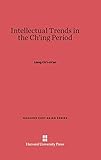Intellectual Trends in the Ch’ing Period (‹i›Ch’ing-tai hsüeh-shu kai-lun‹/i›) : (‹i›Ch'ing-tai hsüeh-shu kai-lun‹/i›) / Ch'i-ch'ao Liang.
Material type: TextSeries: Harvard East Asian Series ; 2Publisher: Cambridge, MA : Harvard University Press, [2013]Copyright date: ©1959Edition: Reprint 2014Description: 1 online resource (147 p.)Content type:
TextSeries: Harvard East Asian Series ; 2Publisher: Cambridge, MA : Harvard University Press, [2013]Copyright date: ©1959Edition: Reprint 2014Description: 1 online resource (147 p.)Content type: - 9780674184695
- 9780674184732
- 915.1
- DS721
- online - DeGruyter
| Item type | Current library | Call number | URL | Status | Notes | Barcode | |
|---|---|---|---|---|---|---|---|
 eBook
eBook
|
Biblioteca "Angelicum" Pont. Univ. S.Tommaso d'Aquino Nuvola online | online - DeGruyter (Browse shelf(Opens below)) | Online access | Not for loan (Accesso limitato) | Accesso per gli utenti autorizzati / Access for authorized users | (dgr)9780674184732 |
Frontmatter -- Preface -- Contents -- Foreword -- Introduction -- Translation -- Foreword -- Author’s First Preface -- Author’s Second Preface -- PART I. The Early Ch’ing Period: The School of “Practical Statesmanship” and Other Trends -- Section 1. Introduction -- Section 2. General Setting -- Section 3. Reaction to Sung-Ming Neo-Confucianism -- Section 4. Ku Yen-wu (1613–1682) -- Section 5. Yen Jo-chü (1636–1704) and Hu Wei (1633–1714) -- Section 6. Huang Tsung-hsi (1610–1695) and Wang Fu-chih (1619–1692) -- Section 7. Yen Yuan (1635–1704) -- Section 8. Met Wen-ting (1632–1721), Ku Tsu-yü (1631–1692), and Liu Hsien-t’ing (1648–1695) -- Section 9. Summary -- PART II. The Middle Ch’iiig Period: The Dominance of the School of Empirical Research; The Beginnings of Reaction -- Section 10. Hui Tung [1697–1758] -- Section 11. Tai Chen [1724–1777] -- Section 12. Tuan Yü-ts’ai [1735–1815], Wang Nien-sun [1744–1832], and Wang Yin-chih [1766–1834] -- Section 13. Summary -- Section 17. Notation-Book and Literary Style -- Section 18. General Encouragement of Scholarship in the Society -- Section 19. The Ancient-Style Writers: The T’ung-ch’eng School and the Tang-hu School -- PART III. The Late Ch’ing Period: The Modern Text School and Other New Trends -- Section 20. Division in the Ch’ing School of Learning -- Section 21. Modern Texts versus Ancient Texts -- Section 22. The Kung-yang Commentary -- Section 23. K’ang Yu-wei [1858-1927] -- Section 24. K’ang's Ta- t’ung shu -- Section 25. Liang Ch’i-ch’ao [1873–1929] -- Section 26. Contrast between K’ang and Liang -- Section 27. Tan Ssu-t’ung [1866–1898] -- Section 28. Chang Ping-lin [1868–1936] -- Section 29. Translation of Western Works and the “Scholars of New Learning” -- Section 30. Buddhism in the Late Ch’ing -- Section 31. Ch’ing Arts and Literature -- Section 32. An Evaluation of Ch’ing Scholarship -- Section 33. General Conclusion -- NOTES. INDEX -- Notes -- Index -- REFERENCE MATTER, BIBLIOGRAPHY, GLOSSARY -- BIBLIOGRAPHY -- GLOSSARY
restricted access online access with authorization star
http://purl.org/coar/access_right/c_16ec
Mode of access: Internet via World Wide Web.
In English.
Description based on online resource; title from PDF title page (publisher's Web site, viewed 29. Nov 2021)


